Minivans started off as inexpensive, economical, versatile alternatives to both cars and things a lot bigger (SUVs).
But today’s minivans are not-so-mini … and are rarely economical. Either to buy or to drive. Some cost over $40,000 (the Chrysler Town & Country starts at $29,995) and all of them have big V6 engines that drink gas like Sam Kinison drank Jack Daniels.
Which may explain the growing popularity of little jitney bus things like this Dodge (via Fiat) Ram ProMaster City.
If you check the stats, you’ll discover these units are about the same size, footprint-wise, as minivans used to be before they grew to be not-so-mini.
They are thus much smaller – on the outside – than current minivans.
They’re less expensive, too. This one starts just over $23k.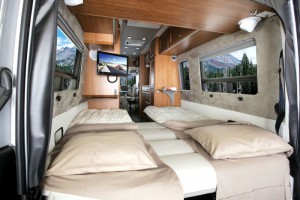
And, they’re more versatile.
You can order one with rear seats and use it as a minivan (or a jitney bus).
Or, delete those rear seats and use the rest of the interior space for a mattress, shelving, cargo, tools – whatever. The low floor (and tall roof) makes it both easy and feasible to haul a motorcycle in the rear of the ProMaster, as an example.
Some people convert these things into mini-me RVs, too.
WHAT IT IS
The ProMaster City is a compact-sized/tall-roofed van that can be kitted out to haul whatever you need to haul. 
It is basically a re-skinned, rebadged version of the Fiat Doblo sold in Europe.
Like its main rivals – the Ford Transit Connect, the Nissan NV200 and the Chevy City (which is a rebadged Nissan NV200) – the ProMaster is built on a car-type, front-wheel-drive chassis and is powered by a small, four-cylinder engine rather than a fuel-thirsty V6, as in all current not-so-minivans.
Like a minivan, it has sliding doors and a low step-in/load height
Base price for the ProMaster City is $23,245 – running to $25,770 for a top-of-the-line SLT.
Rivals include the Ford Transit Connect ($22,560-$29,185), the Chevy Express ($21,955-$23,515) and the Nissan NV200 ($20,720-$21,710). )
The ProMaster is the newest of the Small Three – at least, in the U.S. market.
WHAT’S GOOD
Highest payload rating in its class (1,883 lbs.).
Most cargo capacity in its class (131.7 cubic feet).
Strongest standard engine; standard nine-speed automatic transmission.
Independent/coil spring rear gives better ride/handling than leaf-sprung NV200.
Utilitarian – but not Soviet.
WHAT’S NOT SO GOOD
Ford Transit’s nicer, feels less Soviet.
Chevy Express is cheaper; Nissan NV200’s much cheaper.
Nine speed automatic goes epileptic sometimes.
55 MPG-capable 1.6 liter “Multi-Jet” diesel engine is not available in the “Dodge” (but is in the Fiat).
The first generations of minivans (’80s-era Chrysler vans like the original Dodge Caravan) were based on small cars (like the Aries K-car) and propelled by get-the-job-done four cylinder engines driving the front wheels.
It was sufficient – and that was plenty.
Same deal here.
The PM and its rivals all come standard with four cylinder engines – and all but one of them (the Ford Transit’s optional turbo four) are simple, boilerplate units meant to get you from A to B. Not necessarily quickly, but definitely efficiently.
Pop the PM’s hood and there it is: A transverse-mounted (this is a front-wheel-drive, car-based ride, remember – not a truck-based SUV) 2.4 liter four that produces 178 hp. It’s not a lot of engine for a vehicle with a curb weight of 3,512 lbs. empty.
If, that is, the job is defined as capability – and relative to its rivals. The PM can haul more deadweight inside its cargo area; up to 1,833 pounds vs. 1,500 lbs. for the Chevy and 1,710 for the Ford and just 1,480 lbs. for the Nissan (even though it’s the same vehicle as the Chevy; no idea why it loses 20 pounds of capacity by changing labels).
The PM can also pull up to 2,000 lbs. – as much as the Transit Connect and 100 percent more than the Nissan NV200/Chevy Express which isn’t rated to tow anything at all.
Seriously.
But, understandably.
The NV/Express is the most under-engined of the bunch. Just 2.0 liters and a puny 131 hp to haul its 3,260 lbs. around. Asking that already over-taxed engine to pull something in addition to that would be Abu Ghraib level mechanical abuse and probably a warranty nightmare for Nissan/Chevy, too.
However, the NV200 does deliver best-in-class city mileage: 24 MPG (same as the “Chevy” Express) vs. 21 for the PM and the Transit Connect. Once moving at above stop-and-go speeds, however, both the Ford and the PM pull away, posting 29 MPG on the highway (vs. 26 for Nissan and the “Chevy”) which helps them score higher average numbers.
Acceleration is pretty good for a vehicle like this. One that weighs about the same as a current Camry sedan but has the aerodynamic slipperiness of two Camrys stacked on top of one another.
The PM can make 60 MPH in about 9.7 seconds, which for the record is about two seconds quicker than a current Prius hybrid and in the same ballpark as many current-year compact economy cars.
And you can’t haul your motorcycle inside any of those.
The Ram’s 2.4 engine is paired up with a nine-speed automatic – vs. the six-speed automatic in the Ford and the CVT automatic in the Chevy and Nissan. Fiat – which owns Chrysler (which owns Ram) – has been seeding this new box throughout the corporation’s offerings, including the new Chrysler 200 sedan and Jeep Renegade, among others. You’ll also find it in out-of-the-closet Fiats like the 500X. This additional gearing is advantageous in terms of leverage – getting the vehicle up to speed with less energy (i.e., gasoline) required.
It is one of the reasons for the PM’s strong highway MPG number.
However…
ON THE ROAD
You don’t expect a pig to sing, so when it happens, it’s pretty impressive – even if it’s a little off-key.
The PM is like that in that it accelerates – even handles – not half-badly. Once you’re in it, it feels pretty much like a medium-small crossover wagon.
Better, in some ways.
The view ahead and to your immediate right and left, for example, is exceptionally good because of the very large (and very tall) glass used for the windshield and door glass.
It’s not so great to your rear, of course – due to the tunnel vision of that big empty box behind you and the big “I” beam in between the rear glass.
If you order rear glass.
It’s not included with the base Cargo trim. Neither are windows for the sliding side doors. They’re also extra. But the side mirrors are big – and feature double mirrors, like an RV has – and for the same reasons.
You learn to use – and rely – on them.
The PM is tall – but sits low. Relative to its rivals – and to cars, generally. It has 5.1 inches of clearance vs. 6.5 for the NV200/Express and 6.3 for the Ford. This confers two meaningful advantages. First, the center of mass is closer to the road and this noticeably decreases the top-heavy feeling that would otherwise almost certainly be an issue for a vehicle that stands 74 inches off the pavement (vs. 72.8 for the Ford and 73.7 for the Chevy and the Nissan).
I’ve driven all three extensively in my home turf of rural SW Virginia – up in the Blue Ridge Mountains – where wind buffeting is an everyday thing. The PM is the least unsettled by sudden gusts of the three, despite being the tallest of the three – perhaps because it’s got less air gap under its skirts and that helps it maintain its footing.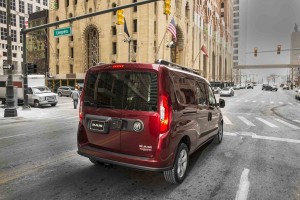
It also makes it feel less industrial getting in and out. Step in height is just 21.5 inches.
Also not-industrial is the PM’s dashboard and general layout. Very car-crossover like.
Like the Transit’s.
Unlike the Nissan NV’s (and the “Chevy” Express’s) which is very much a commercial space.
The PM’s standard nine-speed automatic keeps cruise RPM low. At 70 on level terrain the engine will be turning just under 2,000 revs in ninth – which helps save fuel and also makes the thing feel (and sound) less busy. The top three gears are invisible in that you don’t really notice the transitions up and down – and even when you attempt to manually go up and down via “+” and “-” tapping of the gear selector, the computer mostly keeps you in whatever gear it decides is right for the situation. It won’t go up to 8th or 9th in manual mode, for example, if your speed isn’t high enough (to avoid lugging the engine) even though the display says you’ve moved to 8th or 9th.
However, the transmission has a tendency to impart a sensation that the vehicle is surging forward when going downhill. It jumps up a gear or three – when probably it ought to hold the gear it’s in, or even drop down one to provide an engine braking effect rather than an accelerating-without-touching-the-gas-pedal effect. I’ve noticed this same issue in other Fiat-Chryslers with the nine-speed box.
It’s a little unnerving.
The engine is a strong point – literally. It makes sufficient power (vs. the Nissan’s and the Chevy’s marginal power). The Ford is good on this score, too – but the PM noses ahead because of its greater cargo-hauling capacity.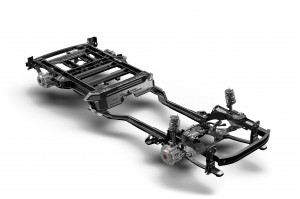
The PM’s longer-than-rivals wheelbase (122.4 inches vs. 120.6 for the Ford and 115.2 for the Express/NV200) is an inherent stability-enhancer and its independent rear suspension delivers an impressively smooth, controlled ride. Also noteworthy is the PM’s much tighter turning circle relative to its rivals: 36.3 feet vs. the Transit’s 40 feet.
The Chevy/Nissan’s 36.7 feet is comparably tight but the rest of the vehicle is much clunkier and clumsier feeling. It’s the go-to one if you want the least expensive one of the bunch, but it’s a case of getting exactly what you pay for.
And, didn’t.
Let’s put things in perspective – in proportion.
A 1984 Dodge Caravan was 175.9 inches long and rode on a 112.1 inch wheelbase. The 2015 Chrysler Town & Country – linear descendant of the ’84 Caravan – is 202.8 inches long and rides on a 121.2 inch wheelbase.
It is huge – and it is expensive.
Thirsty, too (17 city, 25 highway).
Now the PM.
It’s only seven inches longer than the ’84 Caravan – and 15.3 inches shorter overall than the ’15 Town and Country. It’s also 6.6 inches narrow through the hips (72.1 inches vs. 78.7 for the ’15 T&C). The ’84 Caravan was, interestingly also just 72 inches wide – virtually the same as the ’15 PM.
Point being, the dimensions of this van are – with the exception of height – very close to those of the original/first-generation minivans. It is much more svelte than the dimensions of modern minivans like the T&C – which really ought to be be called vans at this point… not minivans.
Another commonality – already touched on – is the simple/functional/space-efficient layout. Despite it being a smaller package on the outside, the PM has nearly as much room inside as the much larger-on-the-outside T&C: 131.7 cubic feet vs. 143.8 for the not-so-mini van. And the PM arguably has more usable real estate because of its tall roof, low load height, dual outward swinging (and 60/40) rear doors (vs. the minivan’s one-piece upward folding liftgate). And, of course, the fact that it can be ordered with just two seats (drive and front seat passenger.
Apples to apples-wise, the PM’s got more cargo capacity than the Transit (128.6 cubic feet) and the Nissan NV/Chevy Express (122.7 cubic feet). But the main point is any of these is more in keeping with the idea behind the first-wave minivans of the early-mid 1980s than the current crop of not-so-mini (or cheap) vans.
The PM is less commercial in demeanor, design, cabin layout and general feel than than very bare-bones Nissan NV/Chevy Express but not quite as – well, luxurious may not be the right word – but something along those lines, relative to the Ford. Which can be ordered with stuff like a peppy turbocharged engine, adaptive headlights, heated leather seats, rain sensing wipers, a full-length panorama sunroof and a longer-wheelbase version with three rows of seats (PM offers just the one wheelbase and one or two-row seating layout).
But, the PM can be ordered with a good stereo (with USB connector and very tactile knob inputs that have just the right amount of drag built into them to make precise, incremental adjustments every time) and a touch-screen GPS (TomTom) LCD screen.
It may not offer heated leather seats like the Transit, but the heater is excellent. Cranked to the hottest setting, it puts out air that feels almost warm enough to melt the plastic vents. That’s the ticket on an 18 degree day in a vehicle with a lot of interior volume (and much of it not insulated, if you order the basic Tradesman (cargo-hauling) trim.
The Ford is good on that score, too. But the Nissan NV/Chevy Express is a cold-hearted bitch.
Dress warm.
THE REST
One very cool – because useful – design aspect of the PM that is unique to the PM is the width between the rear wheel-well humps inside the box. It measures 48 inches, which just happens to be exactly the clearance you’d need if you wanted to slide a pallet in there. And with 51.8 inches of vertical (floor to ceiling) space, you can transport a motorcycle inside – out of the weather. And – trust me on this – it’s a lot easier to roll a bike into something like the PM than it is to push it up into a standard-sized van… much less a pick-up truck (and then your bike’s out in the weather, too).
The optional second-row is a tumble-forward/fold design similar in concept to what you’d find in a standard minivan like the current T&C. They’re easier to move out of the way than either the Ford or Nissan/Chevy’s optional second row.
One thing none of the vehicles in this segment have that they really ought to at least offer is a diesel engine option. Not only for MPG reasons but also to give ’em more grunt – more pulling and hauling capability.
And – guess what? Fiat offers just such an engine in the Doblo – the PM’s European cousin. It is capable of averaging 55 MPG.
But not for us. Because U.S. regulatory rigmarole so expensive, so difficult to comply with, that most European manufacturers no longer even make the attempt.
Meanwhile, the politicos in DC bray about fuel efficiency… .
THE BOTTOM LINE
Any of these is a good choice for an economical to buy and operate hauler of stuff and of people.
The PM’s the best choice, though, if you need to haul the most stuff.
If you value independent media, please support independent media. We depend on you to keep the wheels turning!
Our donate button is here.
If you prefer to avoid PayPal, our mailing address is:
EPautos
721 Hummingbird Lane SE
Copper Hill, VA 24079
PS: EPautos stickers are free to those who sign up for a $5 or more monthly recurring donation to support EPautos, or for a one-time donation of $10 or more. (Please be sure to tell us you want a sticker – and also, provide an address, so we know where to mail the thing!)





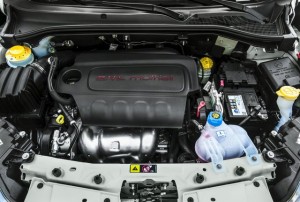

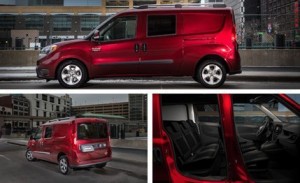
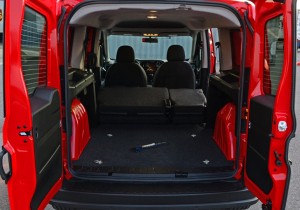
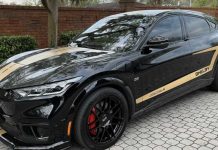






The stripped down Grand Caravan AVP (no power doors/liftgate, no fold-flat seats, no roof rack) is still available – probably around $20,000 out the door.
Only seen one Nissan NV ever driving along a public road and the lone Chevy clone is still on display out front at the Chevy dealer. So are the baby Ram vans at the local FiatChryslerDodgeJeepRam establishment sitting in a row and never move. All are ugly, flimsy looking things.
Transits and Sprinters sold like hotcakes from day one. They have a more substantial appearance than these newer entrants. One big negative with the Sprinter, they are becoming rust buckets here in the salt belt.
The chassis of the PM is being used as the basis for an RV (such as the Winnebago Trend) but I don’t think anyone is using the body as an RV like with the Sprinter (Winnebago Era). It’s just not big enough to fit a toilet, a bed, and a kitchen(-ette) in there, which is required for the vehicle to be classified as an RV.
So what about towing one behind a full-sized RV? You can if you put it on a trailer or a tow dolly. You can’t flat-tow it because of the automatic. If only it came with a manual transmission…
Perhaps we call this class microvans. Or redub the Caravan and its descendants/followers as ‘midivans.’
Judging by Chrysler (and Fiat) history in the area of quality control and reliability over the past 25 years or so,this van,and most Chrysler products would be the last vehicles I would spend my hard earned money on. If one takes the time and checks out the long term ,and even short term, quality ranking lists put out by reliable publications Chrysler products,with a few exceptions,consistently scores at the bottom of the list. Every Chrysler product I have bought and used for business purposes literally disintegrated within a few short years. As far as cars are concerned my 1997 Honda Civic still runs well and is tight and rust proof after almost 19 years. How many people can say that about a mid 90s Dodge Neon.
Jerry, ain’t it the truth. The first thing I really liked was the Jeep Wagoneer. They had great 4 WD systems, really strong body metal but their a/c, the air leaks somewhere in the rear that let vast amounts of dust in going down dirt roads and their anemic and short-lived 360 engines sucked the big one. I could shut my eyes and know by the smell of their leather I was opening the door of a Wagoneer. They had good seats too.
A few of the first ones made had Chevy engines and transmissions and were highly desired once they settled on the AMC and Chrysler driveline. I have one in the line-up of dead vehicles and would gladly have swapped the engine/transmission for a GM set-up I had if it hadn’t been wrecked in the back by a guy too speedy to look back and avoid that big tree. I could have eventually tracked down the dust leak, something every single one of them had or at least every one I drove and that was plenty.
Later on, friends who worked for the same company had some really sorry Chrysler product cars and they too would choke you with dust on a dirt road. That was the first and only car I thought I’d be choked to death by the damned seat belt. The dolts who designed that automatic seat belt should have been made to use one to their dying day. Of all the useless, stupid and non-operating stuff that had to take the cake.
If I could find a good Wagoneer body I’d gladly install a GM engine/transmission combo and change some of the electrical/vacuum controls for the 4WD system along with changing to a GM a/c compressor.
The first Wagoneers had an OHC six-cylinder engine designed by Kaiser, the “Tornado.” It was the first mass-produced postwar OHC engine in the U.S. (Strangely it had only six cam lobes, intake and exhaust ran off the same lobe!) Optional engine in early Wagoneers was the Rambler 327 V8 referred to as the “Vigilante.” They originally had available a really funky torsion-bar independent front suspension for 4WD models.
The problem with the AMC 360 engines in the later Wagoneers is mainly the crappy carb and emission controls. It desperately needed fuel injection to meet the standards of the 1980s and early 1990s. (The early 1970s 360 engine in my own car came with few emission controls from the factory and still runs fine over 40 years later.)
BTW, I like the design of the thing but lack of a diesel would keep me away if everything else were fine….so to speak.
There is a trend I’ve seen the last few months and it involves very small crossovers like that little Chevy thing I don’t know the name of. But people are pulling small aluminum trailers that weigh a bit of nothing even fully loaded I suspect. They would appear to be hauling their luggage. Looks like a good idea. The trailers are small enough most have a stinger sticking up so you know where it is when backing.
I saw one of those Chevy things recently and instead of a gold Bowtie on the back it had a black and chrome Batman symbol there and where the name badge should have been there was another black and chrome(a black car with black aftermarket wheels)badge that said Gotham.